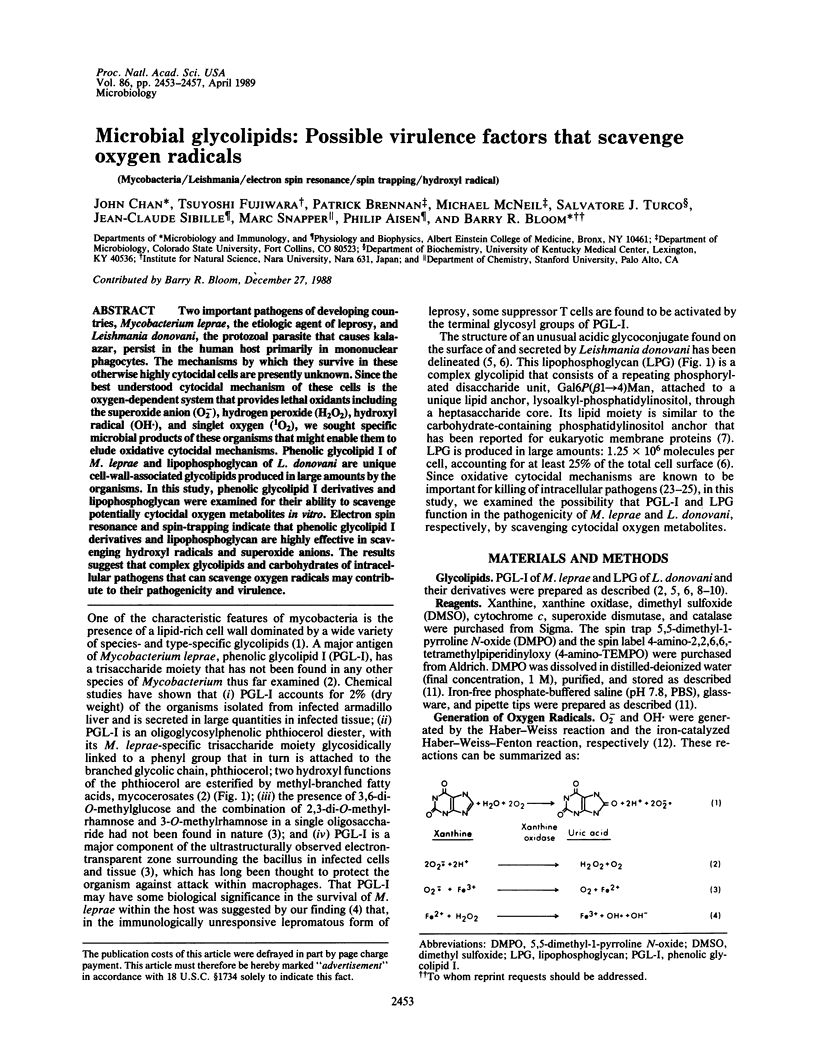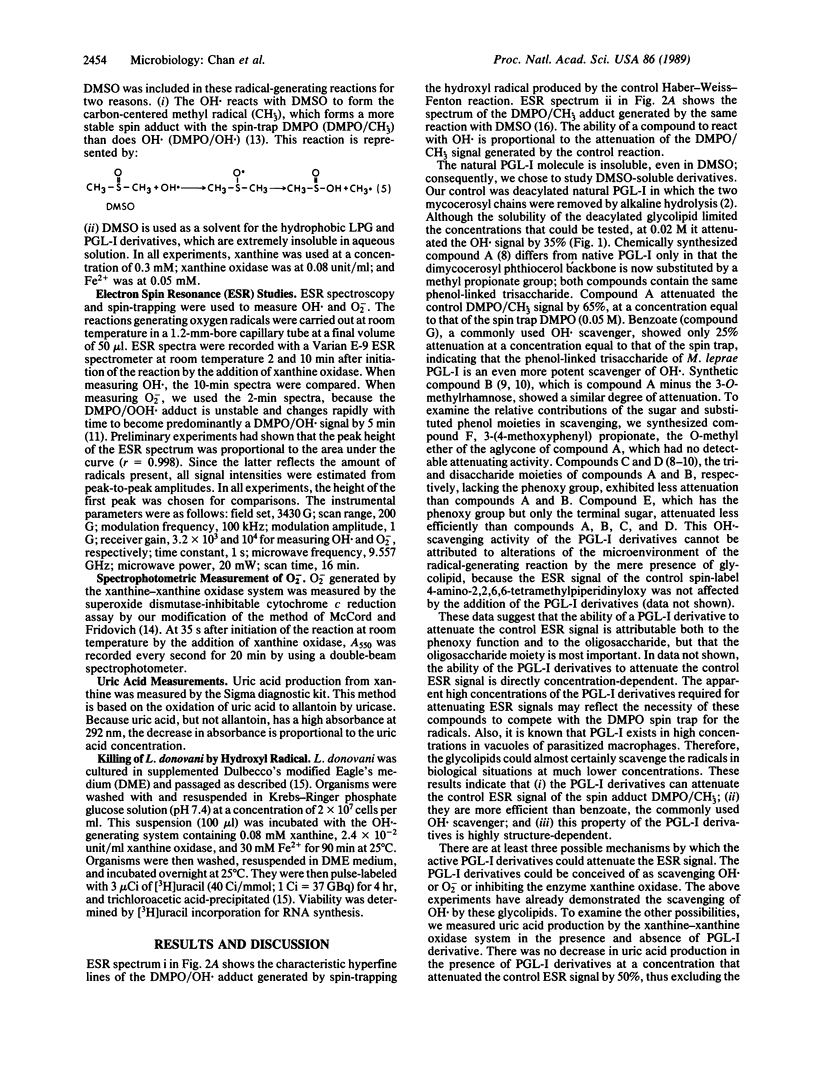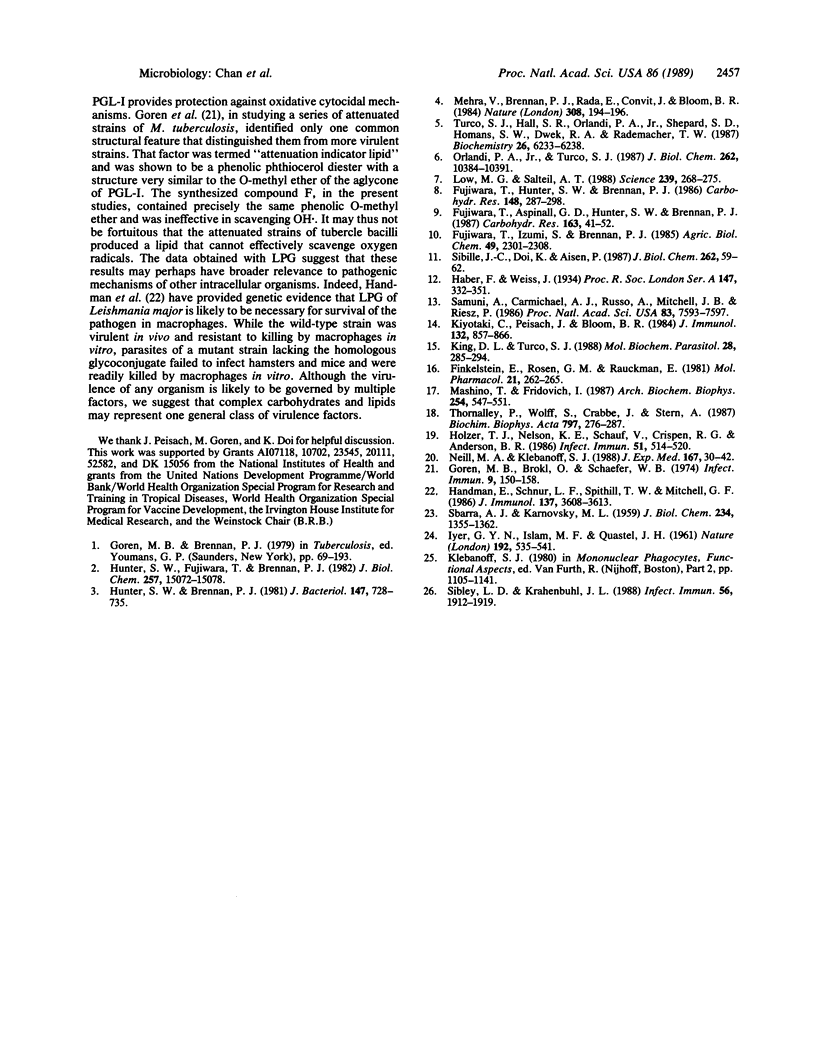Abstract
Two important pathogens of developing countries, Mycobacterium leprae, the etiologic agent of leprosy, and Leishmania donovani, the protozoal parasite that causes kalaazar, persist in the human host primarily in mononuclear phagocytes. The mechanisms by which they survive in these otherwise highly cytocidal cells are presently unknown. Since the best understood cytocidal mechanism of these cells is the oxygen-dependent system that provides lethal oxidants including the superoxide anion (O2-), hydrogen peroxide (H2O2), hydroxyl radical (OH), and singlet oxygen (1O2), we sought specific microbial products of these organisms that might enable them to elude oxidative cytocidal mechanisms. Phenolic glycolipid I of M. leprae and lipophosphoglycan of L. donovani are unique cell-wall-associated glycolipids produced in large amounts by the organisms. In this study, phenolic glycolipid I derivatives and lipophosphoglycan were examined for their ability to scavenge potentially cytocidal oxygen metabolites in vitro. Electron spin resonance and spin-trapping indicate that phenolic glycolipid I derivatives and lipophosphoglycan are highly effective in scavenging hydroxyl radicals and superoxide anions. The results suggest that complex glycolipids and carbohydrates of intracellular pathogens that can scavenge oxygen radicals may contribute to their pathogenicity and virulence.
Full text
PDF




Selected References
These references are in PubMed. This may not be the complete list of references from this article.
- Finkelstein E., Rosen G. M., Rauckman E. J. Production of hydroxyl radical by decomposition of superoxide spin-trapped adducts. Mol Pharmacol. 1982 Mar;21(2):262–265. [PubMed] [Google Scholar]
- Fujiwara T., Aspinall G. O., Hunter S. W., Brennan P. J. Chemical synthesis of the trisaccharide unit of the species-specific phenolic glycolipid from Mycobacterium leprae. Carbohydr Res. 1987 Jun 1;163(1):41–52. doi: 10.1016/0008-6215(87)80163-5. [DOI] [PubMed] [Google Scholar]
- Fujiwara T., Hunter S. W., Brennan P. J. Chemical synthesis of disaccharides of the specific phenolic glycolipid antigens from Mycobacterium leprae and of related sugars. Carbohydr Res. 1986 May 1;148(2):287–298. doi: 10.1016/s0008-6215(00)90396-3. [DOI] [PubMed] [Google Scholar]
- Goren M. B., Brokl O., Schaefer W. B. Lipids of putative relevance to virulence in Mycobacterium tuberculosis: phthiocerol dimycocerosate and the attenuation indicator lipid. Infect Immun. 1974 Jan;9(1):150–158. doi: 10.1128/iai.9.1.150-158.1974. [DOI] [PMC free article] [PubMed] [Google Scholar]
- Handman E., Schnur L. F., Spithill T. W., Mitchell G. F. Passive transfer of Leishmania lipopolysaccharide confers parasite survival in macrophages. J Immunol. 1986 Dec 1;137(11):3608–3613. [PubMed] [Google Scholar]
- Holzer T. J., Nelson K. E., Crispen R. G., Andersen B. R. Mycobacterium leprae fails to stimulate phagocytic cell superoxide anion generation. Infect Immun. 1986 Feb;51(2):514–520. doi: 10.1128/iai.51.2.514-520.1986. [DOI] [PMC free article] [PubMed] [Google Scholar]
- Hunter S. W., Brennan P. J. A novel phenolic glycolipid from Mycobacterium leprae possibly involved in immunogenicity and pathogenicity. J Bacteriol. 1981 Sep;147(3):728–735. doi: 10.1128/jb.147.3.728-735.1981. [DOI] [PMC free article] [PubMed] [Google Scholar]
- Hunter S. W., Fujiwara T., Brennan P. J. Structure and antigenicity of the major specific glycolipid antigen of Mycobacterium leprae. J Biol Chem. 1982 Dec 25;257(24):15072–15078. [PubMed] [Google Scholar]
- King D. L., Turco S. J. A ricin agglutinin-resistant clone of Leishmania donovani deficient in lipophosphoglycan. Mol Biochem Parasitol. 1988 Apr;28(3):285–293. doi: 10.1016/0166-6851(88)90013-8. [DOI] [PubMed] [Google Scholar]
- Kiyotaki C., Peisach J., Bloom B. R. Oxygen metabolism in cloned macrophage cell lines: glucose dependence of superoxide production, metabolic and spectral analysis. J Immunol. 1984 Feb;132(2):857–866. [PubMed] [Google Scholar]
- Low M. G., Saltiel A. R. Structural and functional roles of glycosyl-phosphatidylinositol in membranes. Science. 1988 Jan 15;239(4837):268–275. doi: 10.1126/science.3276003. [DOI] [PubMed] [Google Scholar]
- Mashino T., Fridovich I. Superoxide radical initiates the autoxidation of dihydroxyacetone. Arch Biochem Biophys. 1987 May 1;254(2):547–551. doi: 10.1016/0003-9861(87)90136-6. [DOI] [PubMed] [Google Scholar]
- Mehra V., Brennan P. J., Rada E., Convit J., Bloom B. R. Lymphocyte suppression in leprosy induced by unique M. leprae glycolipid. Nature. 1984 Mar 8;308(5955):194–196. doi: 10.1038/308194a0. [DOI] [PubMed] [Google Scholar]
- Neill M. A., Klebanoff S. J. The effect of phenolic glycolipid-1 from Mycobacterium leprae on the antimicrobial activity of human macrophages. J Exp Med. 1988 Jan 1;167(1):30–42. doi: 10.1084/jem.167.1.30. [DOI] [PMC free article] [PubMed] [Google Scholar]
- Orlandi P. A., Jr, Turco S. J. Structure of the lipid moiety of the Leishmania donovani lipophosphoglycan. J Biol Chem. 1987 Jul 25;262(21):10384–10391. [PubMed] [Google Scholar]
- SBARRA A. J., KARNOVSKY M. L. The biochemical basis of phagocytosis. I. Metabolic changes during the ingestion of particles by polymorphonuclear leukocytes. J Biol Chem. 1959 Jun;234(6):1355–1362. [PubMed] [Google Scholar]
- Samuni A., Carmichael A. J., Russo A., Mitchell J. B., Riesz P. On the spin trapping and ESR detection of oxygen-derived radicals generated inside cells. Proc Natl Acad Sci U S A. 1986 Oct;83(20):7593–7597. doi: 10.1073/pnas.83.20.7593. [DOI] [PMC free article] [PubMed] [Google Scholar]
- Sibille J. C., Doi K., Aisen P. Hydroxyl radical formation and iron-binding proteins. Stimulation by the purple acid phosphatases. J Biol Chem. 1987 Jan 5;262(1):59–62. [PubMed] [Google Scholar]
- Sibley L. D., Krahenbuhl J. L. Induction of unresponsiveness to gamma interferon in macrophages infected with Mycobacterium leprae. Infect Immun. 1988 Aug;56(8):1912–1919. doi: 10.1128/iai.56.8.1912-1919.1988. [DOI] [PMC free article] [PubMed] [Google Scholar]
- Thornalley P., Wolff S., Crabbe J., Stern A. The autoxidation of glyceraldehyde and other simple monosaccharides under physiological conditions catalysed by buffer ions. Biochim Biophys Acta. 1984 Feb 14;797(2):276–287. doi: 10.1016/0304-4165(84)90131-4. [DOI] [PubMed] [Google Scholar]
- Turco S. J., Hull S. R., Orlandi P. A., Jr, Shepherd S. D., Homans S. W., Dwek R. A., Rademacher T. W. Structure of the major carbohydrate fragment of the Leishmania donovani lipophosphoglycan. Biochemistry. 1987 Sep 22;26(19):6233–6238. doi: 10.1021/bi00393a042. [DOI] [PubMed] [Google Scholar]


